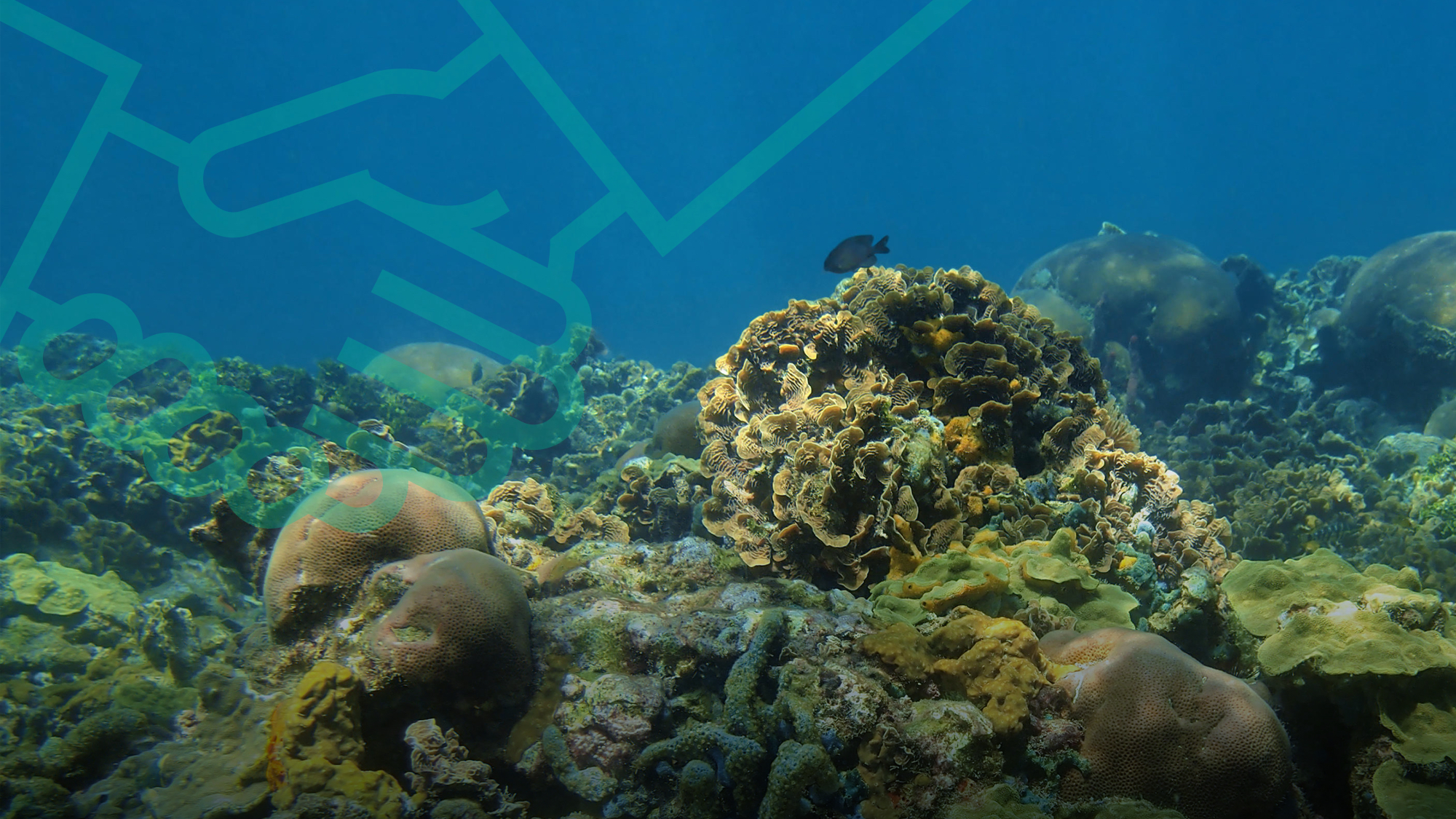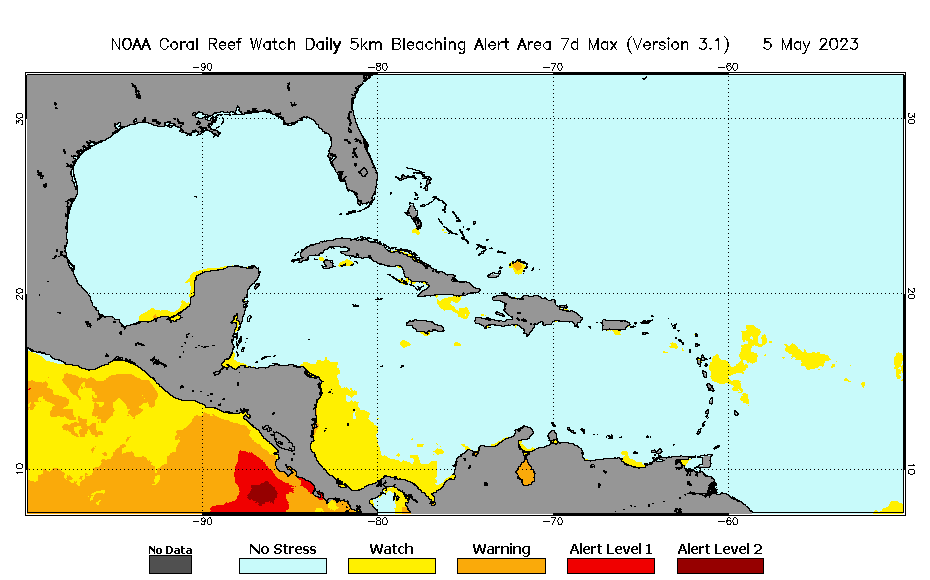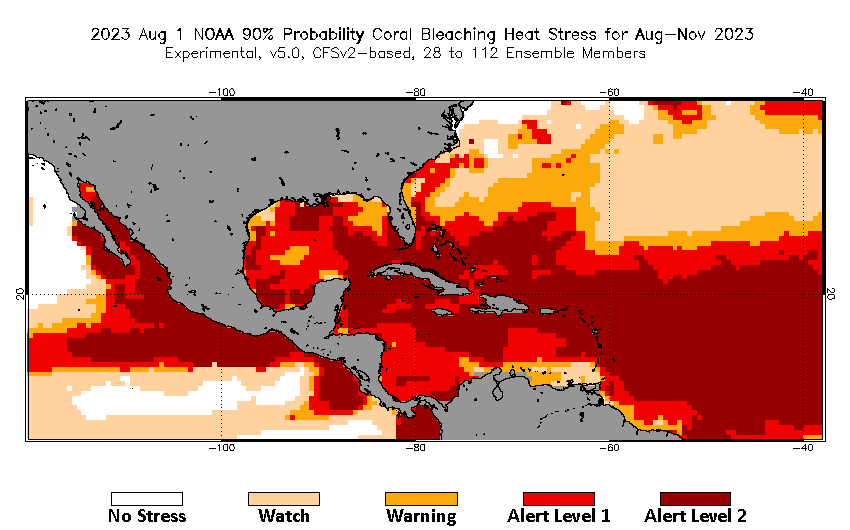
Open Insights: What open data, satellite-based and modelled products forecast for coral bleaching
Following recent reports of coral bleaching in the Florida Keys and off the coasts of some Caribbean countries, in this latest Open Thinking contribution, Callum Scott interviewed Dr Blake Spady, NOAA Coral Reef Watch Scientist and Product Developer, who led the Coral Reef Watch (CRW) study that predicted the 2022 mass bleaching event on the Great Barrier Reef, published on F1000Research.
In this interview Callum and Blake explore why heat stress is so important to coral reefs and what the CRW team’s Four-Month Coral Bleaching Outlook predicts for the Caribbean and Gulf of Mexico in the coming weeks. Blake also discusses the unprecedented intensity of heat stress accumulation in in the Caribbean and now the La Niña climate event, typically associated with increased rainfall and cloud cover, failed to protect the Great Barrier Reef from bleaching in 2022, following the CRW team’s prediction. Blake concludes that in order to prevent annual mass coral bleaching, the focus must be on international cooperation to reduce carbon emissions to net zero.
Record-breaking heat levels in the Northern hemisphere are currently dominating headlines. Your research focuses on heat stress and the bleaching of coral reefs, particularly unprecedented heat stress. Could you explain in lay terms what ‘heat stress’ means and why it affects coral reefs, as well as identifying trends your research has identified in recent years? Should we be concerned and why does coral bleaching matter to the environment?
Dr Blake Spady: Heat stress, from the perspective of corals, is when ocean temperatures rise to a level that exceeds their “usual” summertime maximum. If this stress is prolonged or severe, it disrupts the symbiotic relationship within a coral colony, causing the coral host to expel their endosymbiotic algae (zooxanthellae), a process known as coral bleaching. At very high or prolonged levels of heat stress, this can lead to coral mortality. Trends in recent years suggest that many regions globally are experiencing heat stress more often, which affords less opportunity for recruitment and growth in the periods between mass bleaching events.
While it is too early to predict what may happen in the Southern Hemisphere’s summer this year, are there any indications and/or predictions you can share about heat stress affecting coral reefs globally this year?
Dr Blake Spady: Currently NOAA Coral Reef Watch is actively monitoring the ongoing heat stress event taking place in the eastern tropical Pacific and greater Caribbean regions. We have already received reports of bleaching off the Pacific coasts of Mexico, El Salvador, Costa Rica, and Colombia, as well as off Florida, Belize, Cuba, Panama, and both sides of the Yucatan peninsula. These locations with observed bleaching all correspond with high levels of heat stress in our satellite data. Our Four-Month Coral Bleaching Outlook, which provides weekly forecasts of heat stress for the next 20 weeks, indicates that these areas will likely accumulate additional heat stress. Considering these areas have already been observed to have bleached, this is particularly concerning as additional stress raises the likelihood of mortality. Significant heat stress accumulation is also forecast for the eastern Caribbean islands, including Puerto Rico.

How much further bleaching do the models forecast for this summer?
Dr Blake Spady: The current forecast (as of 25 July 2023) from the NOAA Coral Reef Watch Four-Month Coral Bleaching Outlook product indicates a high likelihood that coral bleaching-level heat stress (up to Alert Level 2, associated with severe coral bleaching and significant mortality) will continue in Florida and the Gulf of Mexico. The Outlook also predicts the bleaching-level heat stress will spread south, impacting the eastern Caribbean, from Cuba to the Lesser Antilles, and the western Caribbean, from the Yucatan peninsula (Mexico) to Colombia. There is also heat stress currently accumulating in the Pacific Ocean, which shows potential for bleaching-level heat stress to spread to some regions of the western tropical Pacific, including the Northwestern Hawaiian Islands.

How does the heat stress and coral bleaching seen/forecast in this region compare to that seen in previous years? Is it unique or unprecedented?
Dr Blake Spady: Heat stress accumulation within the Caribbean has never before reached this level of intensity or extent this early in the summer season for any year within the satellite record (1985-present). Certain regions, including the Florida Keys, have already exceeded their historical maximum values of sea surface temperature and accumulated heat stress, with several additional weeks of high temperatures expected. Heat stress in these regions typically continue to accumulate into September, so there is potential for environmental damage beyond what has been reported so far.
What are the implications of this for marine life in the region?
Dr Blake Spady: The ongoing heat stress event within the Caribbean and eastern tropical Pacific could be devastating for the reef ecosystems and beyond. If the bleached corals remain bleached for a prolonged period, this could lead to mass mortality. There have been multiple reports of severe, mass coral bleaching throughout the Florida Keys since the middle of July. Certain nursery/restoration areas in Florida are reporting high levels of mortality, with the restoration area at Sombrero Reef reporting 100% coral mortality. Countless marine taxa would be adversely affected by mass coral mortality including species of fishes, crustaceans, echinoderms, marine molluscs, sea birds and more, all of which have a close association and reliance on coral reefs for habitat, spawning grounds, or a source of food.
In the article published at the end of last year (2022) on F1000Research’s Climate Gateway, your team concluded that, “The Great Barrier Reef is starting the 2021-2022 summer season with more accumulated heat than ever before, which could have disastrous consequences for the health, recovery, and future of this critical reef system.” The implication was that the Great Barrier Reef was predicted to undergo its sixth mass coral bleaching event. Did this prediction come true?
Dr Blake Spady: Unfortunately, this prediction was correct. The Great Barrier Reef was confirmed to have undergone a mass coral bleaching event, primarily throughout the central and northern regions, as our heat stress products suggested. Aerial surveys conducted by the Great Barrier Reef Marine Park Authority and Australian Institute of Marine Science found bleaching in 91% of the 719 observed reefs.
In your 2022 article, your team also conclude that “La Niña, and more specifically high cloud cover, could provide the Great Barrier Reef with some relief from heat stress.” What other climate events such as La Niña are predicted in the near future and what effect might they have on heat stress and coral bleaching?
Dr Blake Spady: It was our hope going into the 2022 summer season on the Great Barrier Reef, that increased rainfall and cloud cover typically associated with La Niña in the region could reduce heat stress accumulation to a level that would spare the reef from mass bleaching. Unfortunately, this was not the case and the Great Barrier Reef was observed to undergo a mass bleaching event during La Niña for the first time. It appears now, that we may no longer be able to rely on the phase of the El Niño-Southern Oscillation as an indicator of whether a region will experience anomalous sea surface temperature conditions. One of the great fears among coral reef scientists is that we are marching towards instances of annual mass bleaching. In order to avoid this, the primary focus needs to be on international cooperation in reducing carbon emissions to net-zero.
Why did the team publish the study as open research?
Dr Blake Spady: NOAA Coral Reef Watch is a publicly funded organisation, and we make all of our research and data openly available to the public. This means that all data, as well as all satellite-based and modelled products developed, are freely available for anyone to use, from policy makers discussing appropriate actions in response to environmental changes and impacts, to concerned members of the public.
Learn more on our Open Insights series here: Thinking Critical – F1000
